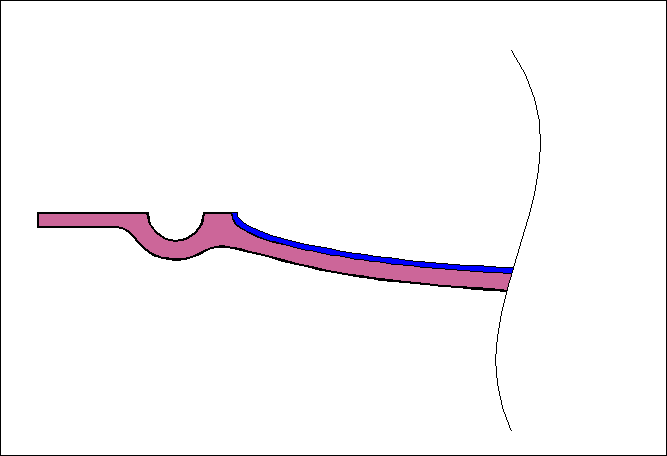
In the last the next Update, I said that I'd show another strange leading edge joint I've encountered inside small parts such as horizontal stabilizers and elevators. This particular joint sorta gives me the willies since it looks, well, inelegant. That's the best word I can think of for it. However, service history speaks volumes, and there are literally thousands of ships of the type in which we found this joint, so I can't say that its bad.
Anyhow, here's what we found when Brad Hill cut apart the horizontal stabilizer from an example of one popular sailplane. The dark blue is the top skin, the red is the bottom skin, the pink is some sort of filler shmoo, and the light blue areas are two styrofoam dams, apparently included to keep the shmoo in place until it cures. There appears to be no leading edge joggle whatsoever, and that the only joint between the upper and lower skins at the leading edge is this bar of pink shmoo. In the example that Brad cut open, the shmoo really does have that pinkish color. And though it is the exact color of winter-catalyzed Bondo, it's almost certainly epoxy-based - real Bondo is polyester-based and would have eaten the styrofoam dams. To my fingernails, it felt talc-like like Bondo, but it's more likely a mix of high-strength fillers such as flox or milled glass fibers, with maybe a touch of cabocil and/or microballoons to smooth it out.

As much as it rubs me the wrong way to use a solid blob where a strip or membrane would do, this joint apparently works fine for small parts such as where we found it.
Anyhow, from what we saw, it looks like this is how they got that joint. First, they lay up one surface, say, the top.

Then they lay up the bottom.

Then they install the foam shmoo dam on one surface, and fill behind it with the pink goo.

And next they do the same with the opposite surface. Note that the heights of the shmoo dams have to be carefully calibrated. Too high and they meet and prevent full closure. Too short and too much shmoo escapes. They probably just use a straight-edge along the leading edge flange of the mold to check the height, and sand down any spots where the dam crest is proud.

Then they bring the two together, and let the two shmoo fills meld into one solid bar. My bet is that they probably tip the whole mold assembly leading-edge-down after the joining, so the shmoo bar gets good contact with the skin.

After the shmoo bar cures, they crack the mold open and liberate the horizontal tail or control surface or whatever.

page updated 28 August 2006 all text and graphics copyright (c) 2006 HP Aircraft,
LLC